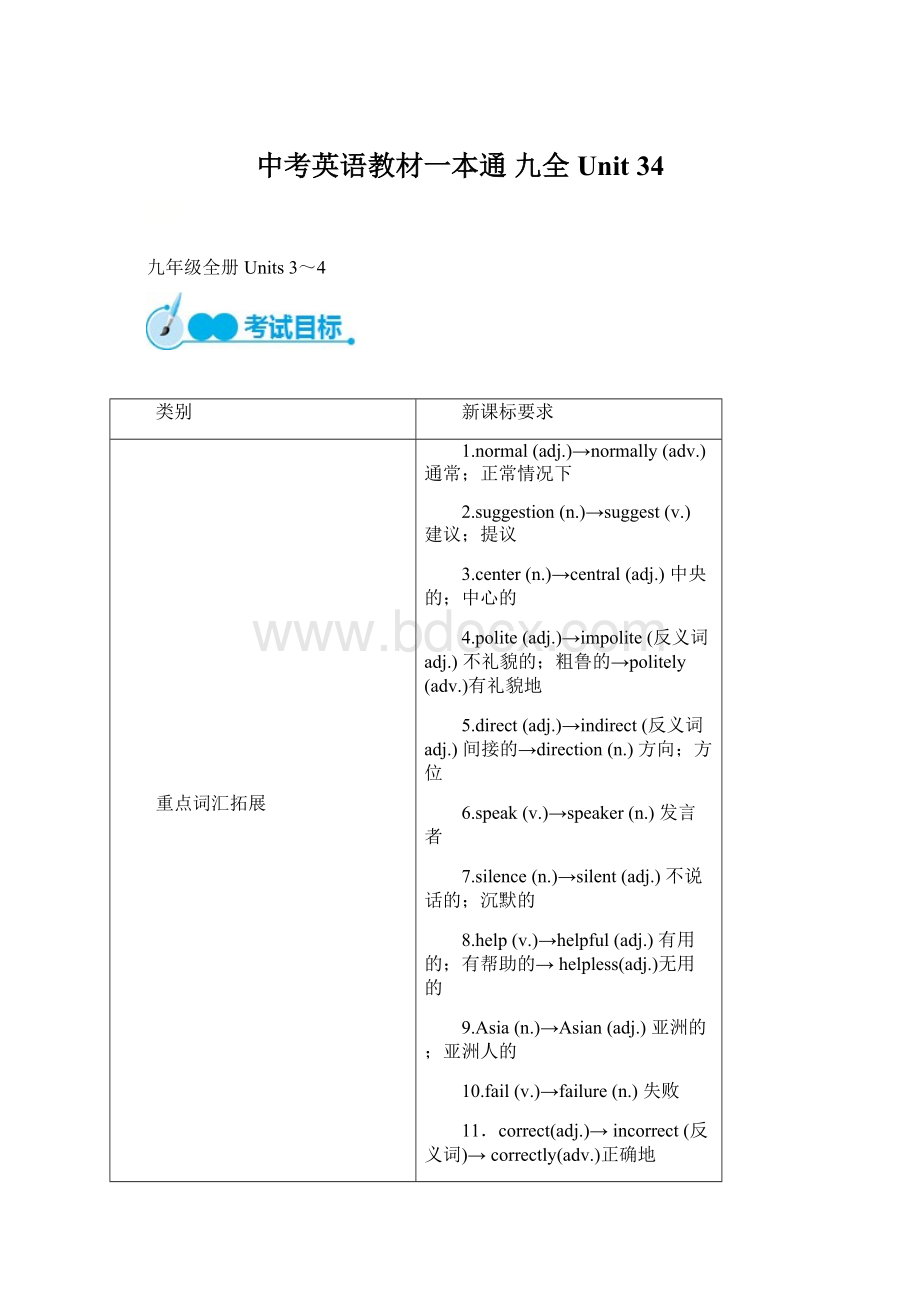中考英语教材一本通 九全 Unit 34.docx
《中考英语教材一本通 九全 Unit 34.docx》由会员分享,可在线阅读,更多相关《中考英语教材一本通 九全 Unit 34.docx(23页珍藏版)》请在冰豆网上搜索。

中考英语教材一本通九全Unit34
九年级全册Units3~4
类别
新课标要求
重点词汇拓展
1.normal(adj.)→normally(adv.)通常;正常情况下
2.suggestion(n.)→suggest(v.)建议;提议
3.center(n.)→central(adj.)中央的;中心的
4.polite(adj.)→impolite(反义词adj.)不礼貌的;粗鲁的→politely(adv.)有礼貌地
5.direct(adj.)→indirect(反义词adj.)间接的→direction(n.)方向;方位
6.speak(v.)→speaker(n.)发言者
7.silence(n.)→silent(adj.)不说话的;沉默的
8.help(v.)→helpful(adj.)有用的;有帮助的→helpless(adj.)无用的
9.Asia(n.)→Asian(adj.)亚洲的;亚洲人的
10.fail(v.)→failure(n.)失败
11.correct(adj.)→incorrect(反义词)→correctly(adv.)正确地
12.interview(v.&n.)→interviewer(n.)采访者
13.proud(adj.)→pride(n.)自豪;骄傲
14.examination(n.)→examine(v.)检查;检验
15.introduction(n.)→introduce(v.)介绍
重点短语记忆
1.getto到达
2.goalong沿着
3.turnright向右拐
4.passby经过;路过
5.pardonme请再说一遍;抱歉
6.askforhelp向寻求帮助
7.fromtimetotime时常;有时
8.dealwith处理;应对
9.daretodosth.敢做某事
10.gettoomuchattention得到太多的关注
11.worryabout为……而担忧
12.theroadtosuccess通往成功的路
13.beafraidof害怕
14.inpublic公开地
15.causesomeproblems惹许多麻烦
16.makeadecision做决定
17.inperson亲身;亲自
18.takepridein为……感到自豪
19.beproudof为……骄傲
20.holdone'shand握住某人的手
21.beproudof为……骄傲
22.bemore_interestedin对……更感兴趣
23.takeup从事;占用
24.toone'ssurprise令人吃惊的是
25.eventhough/if即使;尽管
26.takecare_of照顾
重点句型整理
1.—Excuseme,doyouknowwhereIcanbuysomemedicine?
打扰一下,你知道我可以在哪儿买到药吗?
—Sure.There'sasupermarketdownthestreet.当然,这条街上有一家超市。
2.—Couldyoupleasetellmehowtogettothepostoffice?
你能告诉我如何到达邮局吗?
—Sorry,I'mnotsurehowtogetthere.很抱歉,我不确定如何到达那儿。
3.Iwonderwhereweshouldgonext.我不知道接下来我们应该去哪儿。
4.Iusedtobeafraidofthedark.我曾经怕黑。
5.Youusedtobeshort,didn'tyou?
你曾经很矮,是吗?
6.Youwon't/neverknowuntilyoutrysomething.直到你尝试你才知道一些事。
7.Iwasscaredatfirst,butshoutingreallydidhelp.起初我很害怕,但喊叫还真的很管用。
8.Sometimesweevenneedtospendtimeleadingintoarequest.有时我们甚至需要花些时间来导入一个请求。
9.Ithasbeenthreeyearssincewelastsawourprimaryschoolclassmates.自从我们最后一次见到我们的小学同学已经有三年了。
10.Shedidn'tusetowatchalotofmovies.她过去没看很多电影。
11.ManytimesIthoughtaboutgivingup,butIfoughton.许多次我都想到放弃,但我还是奋力坚持下去。
12.Theheadteacheradvisedhisparentstotalkwiththeirsoninperson.校长建议他的父母亲自与孩子谈谈。
13.Hisparents'lovehasmadehimfeelgoodabouthimself.他的父母的爱已使他对自己感到棒极了。
【常考词汇】
1.suggest
【知识点睛】suggest动词,意为“建议;提议”,常用于以下结构中:
suggeststh.(tosb.)(给某人)提议某事suggestdoingsth.建议做某事
suggest+that从句(从句中的谓语动词用“should+动词原形”,should常可省略)
Hesuggestedatwo-day-longstayinBeijingonthewayhome.他建议回家时在北京停两天。
Myfathersuggestedsendingforadoctoratonce.父亲建议马上请个医生。
Theteachersuggestedthatwe(should)speakasmuchEnglishaspossibleinclass.老师建议我们要尽可能多地在课堂上讲英语。
【即时演练】
1)Annsuggestedgo(go)totheSummerPalacenextSunday.
2)黄老师建议我们每天刷牙。
Mr.Huangsuggestedthatwebrushourteetheveryday.
2.whom
【知识点睛】whom代词,意为“谁;什么人”,在句中作宾语。
注意:
who是主格,在句中作主语;whom是宾格,在句中作宾语。
在英语中常可用
who来代替whom,若介词提前,则只能用whom。
Whomdidyoumeetatthetrainstation?
你在火车站遇见谁了?
Towhomwereyoutalkingjustnow?
刚才你在和谁说话?
【即时演练】1)DoyouknowAIsawyesterday?
Itwasmyfavoritestar,Jackie!
A.whomB.whenC.whereD.how
3.require
【知识点睛】require作动词,意为“需要,要求”,常用于以下结构中:
requiresth.需要某物requiredoingsth.需要被……requiresb.todosth.要求某人做某事requiresth.ofsb.向某人要求某物
Thisroomrequirescleaning.这个房间需要打扫了。
Theteacherrequiresustogetupearlyeverymorning.老师让我们每天早上早起。
Youcanrequirehelpofthepolice.你可以向警察求救。
【即时演练】1)Thepolicerequiresthetraveller(open)hissuitcase.
4.politely
It'simpolitetospeakloudlyinpublic.在公共场合大声说话是不礼貌的。
Sheisverypolitewhenshetalkswithothers.当她和别人谈话时,很有礼貌。
5.silentadj.不说话的;沉默的
【知识点睛】silent其名词形式是silence,意为“寂静,沉默”,常用于insilence结构中。
silently是其副词形式,意为“寂静地,沉默地”。
Hewalksinsilence.他静静地走着。
6.helpfuladj.有用的;有帮助的
【知识点睛】常用于behelpfulfor结构中,意为“对……有帮助”。
ThecomputerishelpfulforourEnglishstudy.电脑对我们的英语学习非常有帮助。
【归纳拓展】helpn.&v.帮助
(1)helpsb.(to)dosth.帮助某人(做)某事
(2)helpsb.withsth.在某方面帮助某人
(3)helponeself请自便
(4)help(sb.)out帮助(某人)摆脱困难
(5)withthehelpof…在……的帮助下
【即时演练】Theblindmanwalkedacrossthestreet__D__thehelpofaboy.
A.byB.atC.inD.with
7.publicn.民众adj.公开的;公众的
【知识点睛】
(1)thepublic意为“公众”,作主语时,谓语动词用复数形式。
Thepublicaren'tinterestedinthisquestion.公众对这个问题不感兴趣。
(2)inpublic公开地;在别人(尤指生人)面前
It'snotpolitetospitinpublic.在公共场合吐痰是不礼貌的。
8.influencev.&n.影响
【知识点睛】influence作名词时,常用于短语haveaninfluenceonsb.中,意为“对某人有影响”。
Theeventoftheherohasagreatinfluenceonhim.英雄的事迹对他有很大的影响。
易错辨析
1.Couldyoupleasetellmehowtogettothepostoffice?
你可以告诉我怎样去邮局吗?
Couldyoupleasetellmewheretherestroomsare?
请你告诉我洗手间在哪里好吗?
(Unit3)
【知识点睛】
(1))“Couldyou(please)+动词原形?
”意为“请你……好吗?
”表示礼貌地请求对方做某事,在语气上比can更委婉。
其否定句式是“Couldyou(please)not+动词原形?
”否定回答:
Sorry,Ican't.
—Couldyoupleaseanswerthetelephone?
你能接一下电话吗?
—Sure./Sorry,Ican't.I'mtoobusynow.当然可以。
/对不起,我不能,我现在太忙。
(2)第一句句中“疑问词+todosth.”构成动词不定式短语,作宾语。
此句是个简单句,可转化为含宾语从句的复合句:
CouldyoutellmehowIcangettothepostoffice?
第二句由where引导的特殊疑问句作宾语从句,要用陈述语序。
Doyouknowwhenthebankclosestoday?
你知道这家银行今天什么时候关门吗?
【归纳拓展】
❶不定式与疑问词who,which,when,where,how,what等连用,常用于tell,show,know,teach,learn,explain,remember等后面作宾语。
Ididn'tknowwhattosay.我不知道说什么。
❷“疑问词+不定式”结构也可在句中充当主语、表语等。
Howtogetthereisaquestion.怎么去那里是个问题。
Theproblemiswhichtochoose.问题是选择哪一个。
❸问路的句型:
Excuseme,whereisthe(nearest)postoffice?
打扰一下,请问(最近的)邮局在哪儿?
=Wouldyoupleasetellmewherethe(nearest)postofficeis?
=Excuseme,whichisthewaytothe(nearest)postoffice?
=Excuseme,can/couldyoutellmethewaytothe(nearest)postoffice?
=Excuseme,howcan/doIgettothe(nearest)postoffice?
Excuseme,canyoutellmehowtogettothenearesthospital?
你能告诉我怎样才能到最近的医院吗?
=Excuseme,isthereahospitalnearby(nearhere)?
=Wouldyoupleasetellmeifthereisahospitalnearby?
Couldyoupleasetellmewherethere'sagoodplacetoeat?
你能告诉我哪儿有吃东西的好地方吗?
温馨提示:
❶why与不定式连用时,动词不定式不带to。
❷“疑问词+不定式”结构作主语时,谓语动词一般用单数。
(3)getto意为“到达”,后跟地点名词。
Weweregladtogettothetopofthemountain.到达了山顶,我们很高兴。
【归纳拓展】
❶arrive意为“到达”时,是不及物动词,后接较大的地点名词时,用介词in,接小地方时,用at。
❷reach表“到达”时,是及物动词,后直接跟地点名词。
MyfriendgottoBeijingbyairat9:
00p.m.
=MyfriendarrivedinBeijingbyairat9:
00p.m.
=MyfriendreachedBeijingbyairat9:
00p.m.我的朋友在晚上九点乘飞机到达北京。
温馨提示:
当后接here,there,home等地点副词时,getto中的to,arriveat/in中的
at/in要省略。
【即时演练】
1)—So,canyoutellmeBheretoday?
—Well,IwaswalkingdownCentreStreetwhenaUFOlanded.
A.whatdidyouseeB.whatyousawC.whendidyouseeitD.whenyousaw
2)—DoyouknowBtheCapitalMuseum?
—NextFriday
A.whenwilltheyvisitB.whentheywillvisitC.whendidtheyvisitD.whenthey
visited
3)—Idon'tunderstandA.
—I'msorry.ButIwasdoingmyhomework.
A.whyyoudidn'twatchthefootballmatchB.whydidn'tyouwatchthefootballmatchC.whyyoudon'twatchthefootballmatchD.whydon'tyouwatchthefootballmatch
4)Ifyoucan'tfindtheplace,IwillshowyouC.
A.whatitisB.whatitwasC.whereitisD.whereitwas
2.Whenyouvisitaforeigncountry,itisimportanttoknowhowtoaskforhelp
politely.当你在外国游览时,知道如何有礼貌地寻求帮助是很重要的。
(Unit3)
【知识点睛】
(1)It's+adj.+todosth.是固定句式,意为“做……是……的”。
It'snecessarytostudyEnglishwell.学好英语是很有必要的。
(2)politely副词,修饰动词。
其形容词为polite。
Heisapoliteboy.他是一个有礼貌的孩子。
Healwaystalkstootherspolitely.他总是很有礼貌地与别人交谈。
3.Itmightseemmoredifficulttospeakpolitelythandirectly.看起来说得客气要比说得直白更难一点。
(Unit3)
【知识点睛】seem动词,意为“好像”,用法如下:
(1)seem+形容词看起来……
Youseemhappytoday.今天你看起来很高兴。
(2)seem+todosth.似乎、好像做某事Iseemtohaveacold.我好像感冒了。
(3)Itseems/seemed+从句看起来好像……;似乎……
Itseemsthatnoonebelievesyou.似乎没有人相信你。
(4)seemlike+n.好像,似乎……
Itseemslikeagoodidea.这好像是一个好主意。
【即时演练】Ann____A____tohaveagoodtimeatthepartyyesterday.
A.seemedB.lookedC.soundedD.seems
4.Iusedtobeafraidofthedark.我曾经怕黑。
(Unit4)
【知识点睛】
(1)usedto是过去时态,用于描述过去经常发生的动作或存在的状态,后跟动词原形。
(2)usedto的否定式可为usednotto,也可为didn’tuseto。
因此usedtodo的反意疑问句中,附加问句部分可用didn't或usedn't。
一般疑问式也有两种:
“Did…usetodosth.?
”或“Used…todosth.?
”
Mr.Lididn'tusetodrinkbeer.=Mr.Liusedn'ttodrinkbeer.李先生不常喝啤酒。
Jimusedtobelateforschool,didn't/usedn'the?
吉姆以前上学常常迟到,对不对?
DidsheusetoliveinShanghai?
/UsedshetoliveinShanghai?
她过去住在上海吗?
【妙辨异同】usedtodosth.意为“过去常常做某事”,表示过去习惯性、经常性的动作或状态,只用于过去时态,暗示现在不做了。
to为不定式符号,后面跟动词原形。
beusedtosth./doingsth.意为“习惯于……。
”可用于现在、过去、将来等多种时态,其中的be动词可用get或become来代替,指的是从不习惯到习惯这一过程的转变,to是介词,后面只能跟名词、代词或动名词。
beusedtodosth.是动词use的被动语态,意味“被用于做某事”,此时的used不是过去式,而是use的过去分词,与be动词一起构成被动结构,可用于各种时态,其后的to是不定式符号,后跟动词原形,不定式表目的,
Iusedtoplaywithmyfriendsafterschool.过去放学后我常常和朋友们一起玩。
Youusedtoseeheralot,didn'tyou?
你过去常见她,不是吗?
Woodisusedtomakepaper.木材用来造纸。
【即时演练】Heusedto____A____inasmallvillage,buthehasbeenusedto________inabigcity.
A.live;livingB.live;liveC.living;living
5....hisfacealwaysturnedredwhenhetalkedtogirls!
当他和女孩谈话时脸就会变红。
(Unit4)
【知识点睛】turnred意为“变红”。
turn此处是系动词,后跟形容词作表语,有“逐渐变得……”的意思。
Theleavesturnyellowwhenautumncomes.当秋天到来时树叶都变黄了。
【归纳拓展】常见的系动词有:
be,feel,look,taste,smell,sound,get,become等。
Heusedtobethin.Hebecomesstrongerandstrongernow.他以前很瘦,现在变得越来越强壮了。
6.Nowshe'snotshyanymoreandlovessinginginfrontofcrowds.现在她不再害羞
了,也爱在众人面前唱歌。
(Unit4)
【知识点睛】not...anymore也可写作not...anymore意为“不再”,相当于“nomore”。
Ican'tstanditanymore!
我再也受不了了!
【妙辨异同】not...anymore与not...anylonger
(1)not...anymore表示再也不重复过去反复发生的动作,强调在数量或次数上